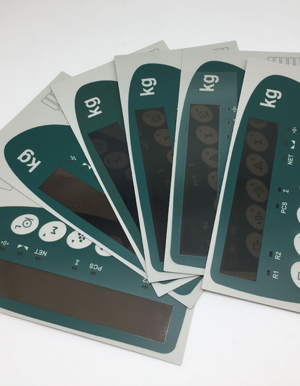Production Technology and Application Trend of Large Size Touch Panel
(2022年)https://www.kom-key.com/graphic-overlay/
In the past, touch panels with large screens could only adopt low-cost resistive or high-cost acoustic wave and external optical designs. Limited by the bonding yield in the past, projected capacitive multi-touch technology could only be used in small and medium-sized mobile devices. With the proficiency of G/G, In-Cell and other manufacturing technologies, as well as the evolution of touch sensing IC, it can now be used in the fields of 10-12 inch tablet, 13-17 inch thin/esports laptop, 20-22 inch AIO integrated computer, etc. Larger size (32 to 42 inches) connected TVs and multi-touch electronic whiteboards are also on the way.
From ATM and mutual assistance navigation systems in institutions, to electronic whiteboards in department stores, these devices that require touch applications are moving towards large-size trends just like mobile phones and tablets.
At present, Apple has only introduced projected capacitive multi-touch technology in small and medium-sized iPhone/iPod/iPad, and has only begun to introduce touchpad feedback power in desktops and laptops, and there are no designs to import a lot of touch applications. However, in the non-Apple camp, from Android phones and tablets to mainstream notebook computers of 12 to 17 inches have introduced projected capacitive multi-touch technology, and even some 20-inch desktop computers or computer dining tables, electronic whiteboards have also begun to use multi-touch technology.
Ⅰ. Production technology of large size touch panel
In the early stage, resistive touch technology, which is more common over 15 inches, is used to touch ITO Film with fingers or stylus, resulting in depression and voltage change, and then obtain the positioning position through A/D conversion operation processing. Due to its early debut, this kind of touch panel has excellent advantages in terms of material and technology costs. However, resistive touch technology has a resistive film that affects the light transmittance of the screen. It adopts a pressure-sensitive mechanical structure, which will reduce the service life under frequent use and long-term large amount of pressing.
Infrared and surface acoustic wave touch technologies are currently common technologies for large-size touch screens. The infrared type is equipped with a large number of infrared transmitters and receivers on the four sides of the screen, and the coordinate position of the touch is calculated by blocking the infrared light source when the finger clicks. Theadvantage is that the applicable size is quite large (6-167 inches); the response speed is fast; the positioning is accurate; and it is also quite durable. The disadvantage is that the infrared module cannot achieve high resolution due to the volume of the infrared module; the cost is high. The falling dust in the future and interference of ambient light are also the bottleneck of this technology.
In the surface acoustic wave type, a surface acoustic wave transmitter and a receiver are installed in the three corners of the screen, and the energy of the sound wave is absorbed when the finger touches the screen to calculate the coordinates of the energy change. Its application size is only 10-32 inches, but it has the advantage of high resolution compared to infrared type. However, as the reflective antenna around the screen needs to be customized and the yield is not high, the overall cost is relatively high.
Ⅱ. Application trend of large size touch panel
When users have become accustomed to the multi-touch experience of smartphones and tablets, many industry players are also actively developing multi-touch application solutions for medium and large screens. It also makes the large touch screen technology, which only used low-cost resistive technology in the past, or the high cost acoustic wave and external optical touch design face certain challenges.
For middle-large touch screens larger than 10.1 inches, a clear overlay or glass touch sensing layer was placed between the cover glass and ITO (TFT Array) or AMOLED panels in the past. The manufacturing method was changed from the GFF (Glass Film Film), the G/G (Glass to Glass Structure) structure shifts to two designs built in the ITO pixel layer (In-Cell) or externally mounted (Out-Cell).
In the case of In-cell, there are existing LCD screen integration solutions for VA/IPS/TN and other forms as well as the design scheme of in-cell collocation covering glass for large screens, which can obtain excellent picture effect in products with large display range, and maintain the material thickness of the screen at the same time. It is more suitable for high-end ultrabooks or morphing laptop products that emphasize thinning product design.
If you want to buy high quality custom membrane keypad, please leave us a message.
As one of graphic overlay manufacturers, we will do our best to meet all customers’ needs.
- このできごとのURL:



コメント